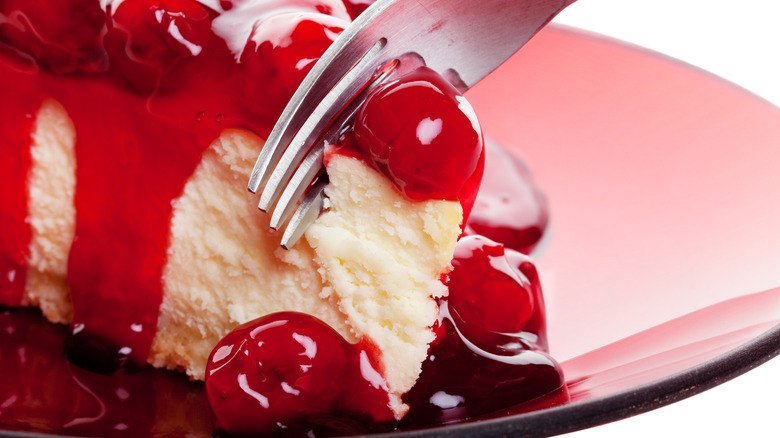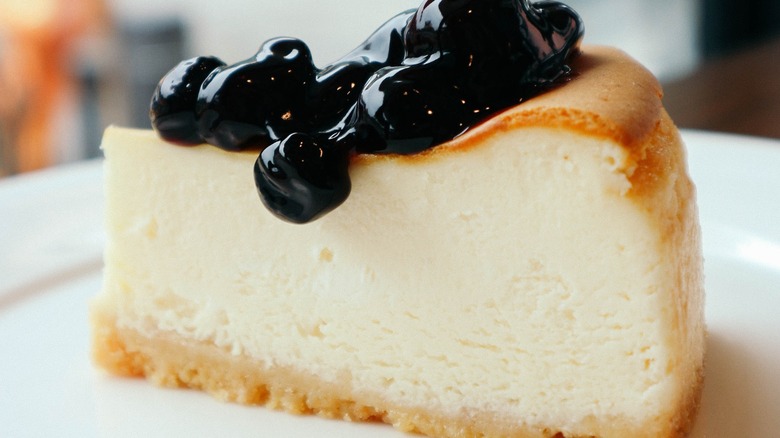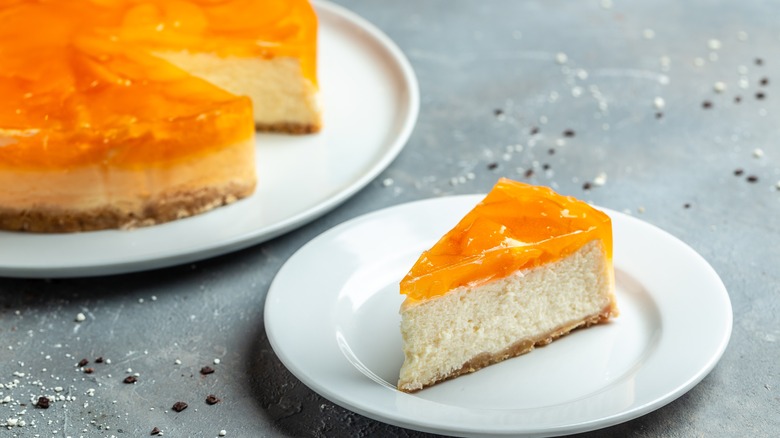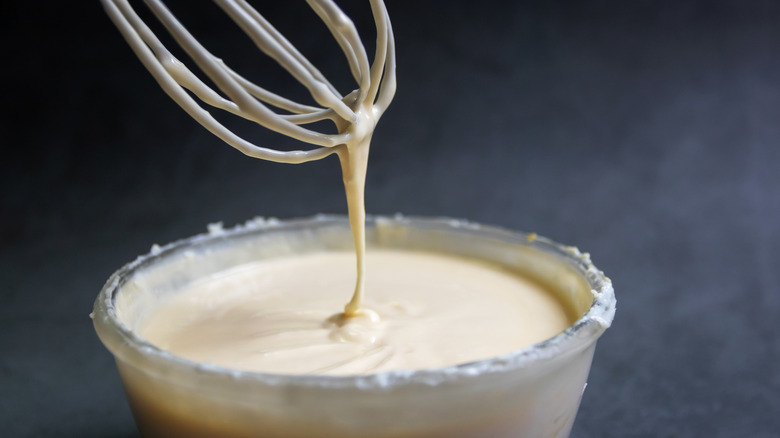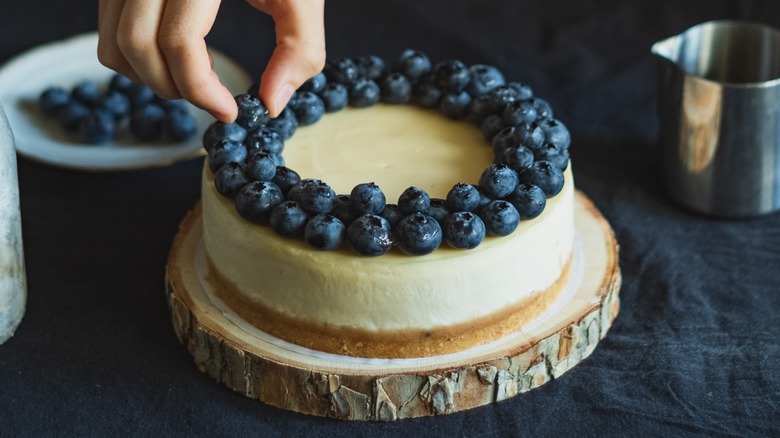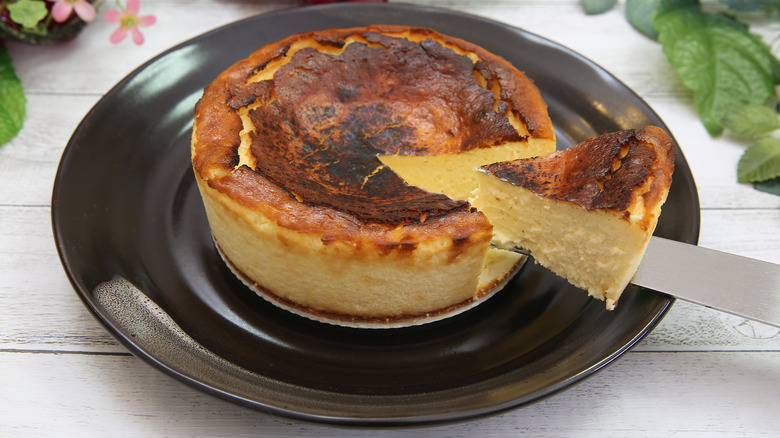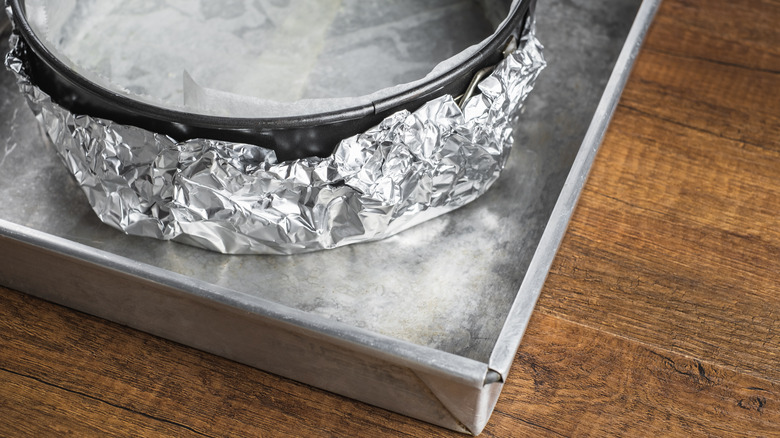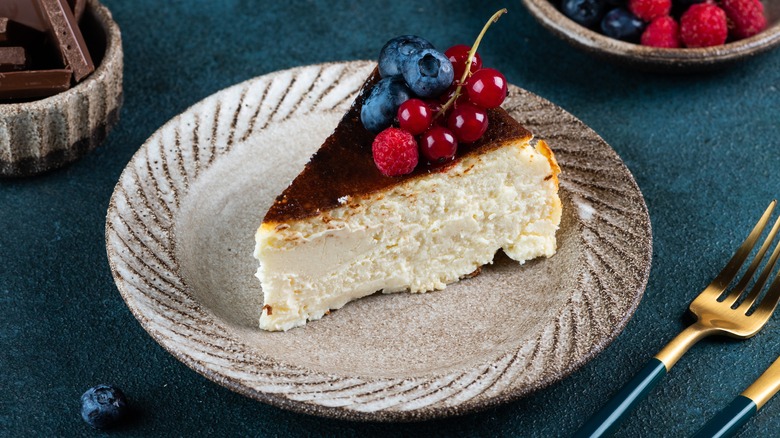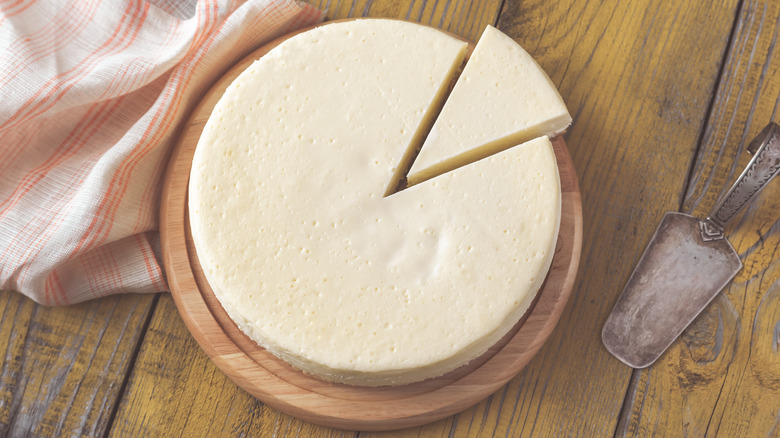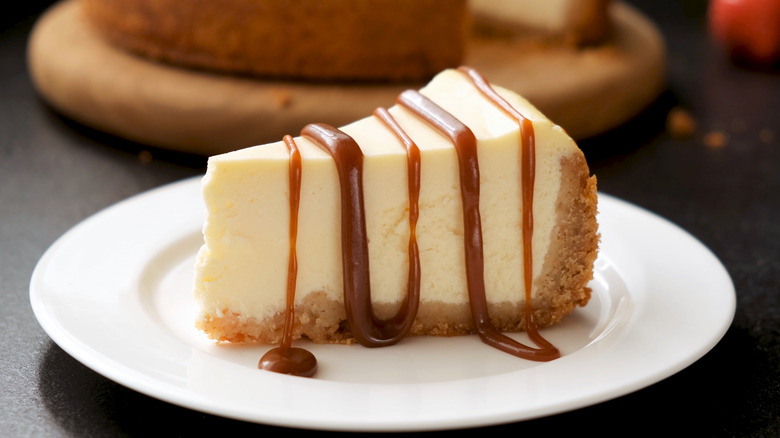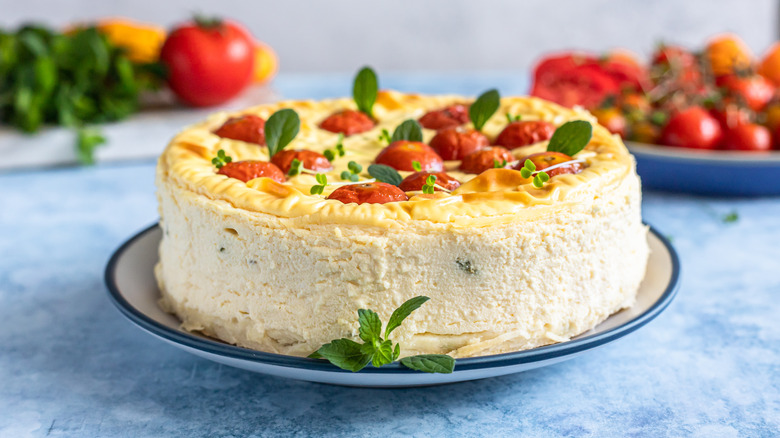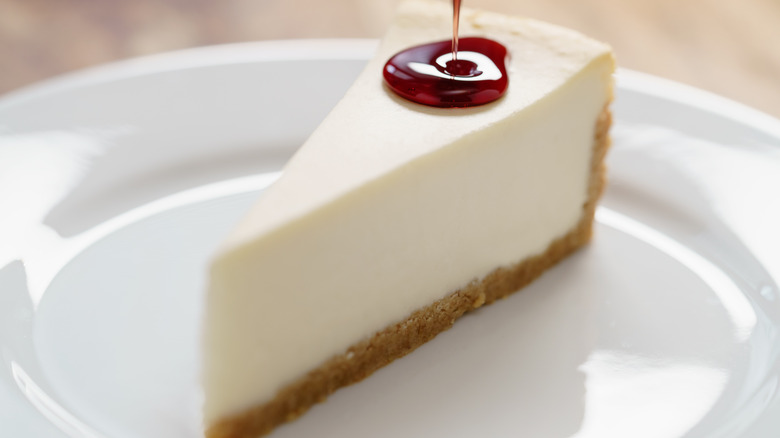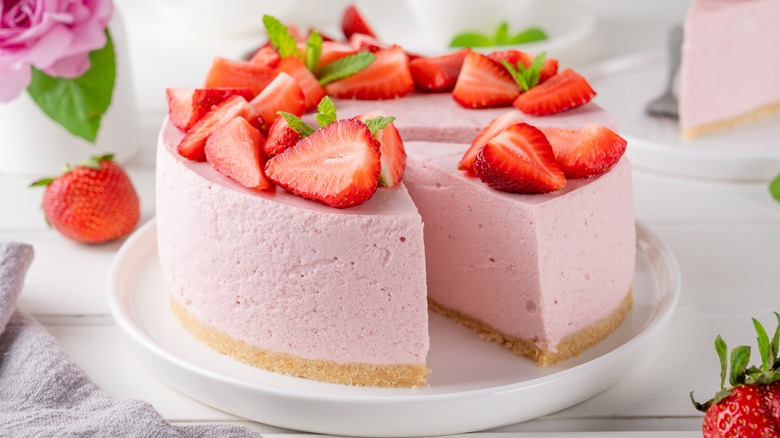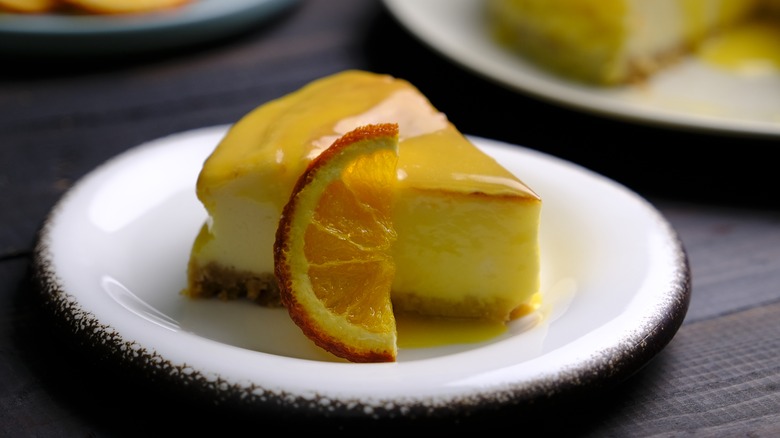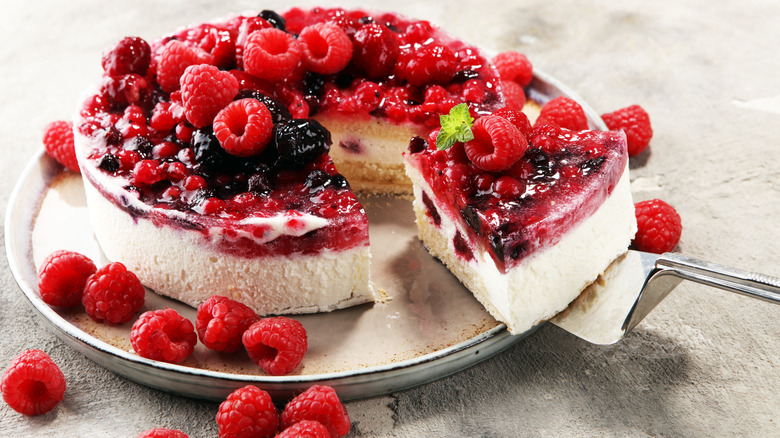The Best Tips You Need To Know Before You Bake Another Cheesecake
Cheesecake is one of the most popular desserts around. Whether it's the old-fashioned New York variety or a rich, chocolatey concoction, cheesecake is a versatile dessert that can gratify just about anyone's foodie predilections. In fact, cheesecake remains so beloved that the pursuit of it can end in a "Lord of the Flies"-esque situation. As ARLNow reports, the Cheesecake Factory decided to give out free cake to customers back in 2018. However, there was an unfortunate rush and a debacle ensued, with delivery drivers for Doordash, who were working with the company for the promotion, causing chaos on the roads. Such is the power of cheesecake to unite and, well, undo.
Baking cheesecake can often be a daunting task. Namely, it requires a whole lot of ingredients in comparison to many other cakes and also omits some traditional baking staples (notably, cheesecake is almost always made sans flour). Moreover, its inclusion of savory ingredients, such as cream cheese, can lead to fears that the finished dessert won't be sweet enough. But before you get cheesed off in the kitchen, remember that perfecting cheesecake, like most good things, requires a little patience and a spoonful of sugar (though not always — more on that later).
Once you've tried out these suggestions, you'll find baking a cakewalk. Here's the lowdown on the best tips you need to know before you bake another cheesecake.
Make it fluffy
Cheesecake comes in many forms and textures, from super solid to creamy. While a smooth classic cheesecake is undeniably delectable, you can up your game by adding a fluffy twist. There's something especially gratifying about scooping up a morsel of light, airy cake with your fork and marveling at that flocculent texture. To achieve this, your best bet is to whisk the egg whites thoroughly, as The Guardian notes. This is because the consistent beating of the egg white allows more air into the mixture, thereby giving you that perfect fluffy quality.
Crack your eggs in half, carefully keeping the yolk in the shell by gently transferring it between the two halves, and then add the white to a bowl. Alternatively, you can buy yolk separators, which are super affordable and will make baking considerably easier for newbies. Then, whisk away vigorously at the white until stiff peaks form. You can either use an electric whisk or if you're able to, you can give your wrists a workout by whisking by hand. You can add the egg white to the rest of your wet ingredients and beat the batter until it's smooth.
Add cornstarch to the mix
Cornstarch has countless uses in cooking. From keeping tofu super firm to thickening soups, cornstarch is the superhero of the cooking world, and its versatility seemingly know no bounds. But its uses are not confined to savory cooking; cornstarch can also be used to up your cake game. It holds the cheesecake together, giving the overall bake a silky look. Using cornstarch (via Kitchn) will also prevent those pesky and unsightly cracks from appearing in the finished product, enabling you to serve flawless slices to your guests.
While cheesecake is typically made without flour, celeb chef Nigella Lawson explains that the addition of cornstarch will help your eggs settle into the batter, while also binding your ingredients as a whole. Depending on how big your bake is, around one to three tablespoons should suffice, which you can add to your dry ingredients to ensure a firm finish. As Reddit users who tried out this boss method explain, cornstarch really does enhance the cheesecake baking experience, but it can also affect your overall texture. This is why it's important that you mix it sufficiently to prevent clumping.
Combine your creams
A rigid cheesecake is rather unpalatable. Unfortunately, the store-bought variety frequently comes with a stodgy, as opposed to smooth, texture, which is usually the result of preservatives being added to the cake. So when you make fresh cheesecake at home, you should strive for a smooth and creamy finish.
To make New York cheesecake, it's advisable that you combine your creams. This is because New York cheesecake, in particular, is known for being heavy on heavy cream (or double cream if you're British). Accordingly, heavy cream alone can be rather burdensome on the stomach. Thus, it's a good idea to add some sour cream to the mix. The addition of sour cream will not only balance out the sometimes-sickly flavor of the heavy cream but soften your mixture as well, bestowing you with that oh-so-silky texture baking foodies know and love. Moreover, sour cream will add a zesty tang to the cake, which is a win for those who find cheesecake to be a tad too sweet.
Add around 1 cup of sour cream to the mix to smooth out your batter. You can also add the sour cream as a topping after you've finished baking. If you opt to do this, you'll need a couple of cups of the cream, mixed with ¼ cup of white sugar. Typically, a sour cream topping goes best with fruits such as raspberries or strawberries.
Ingredients should be at room temperature, but the fridge is your friend
The main ingredients for cheesecake should always, without fail, be left at room temperature before you even consider mixing them. This is to avoid a lumpy batter. If ingredients are cold, you could find yourself stirring away at the mix for what feels like a lifetime to no avail. Ever tried to beat rock-hard, cold cream cheese? It's no piece of cake. But while it's important that your ingredients are kept at room temperature, the finished cake should be put in the fridge for a few hours before being served. Refrigerating your cake will help it settle and can also prevent cracks from forming.
And there's another, less palatable reason cheesecake ought to be refrigerated. According to the U.S. Department of Health & Human Services, cheesecake can be eaten within five to seven days after it's made — but only if it's kept refrigerated. The Food Safety and Inspection Service notes that food shouldn't be left out of the refrigerator for any longer than a couple of hours. Bacteria can develop in the eggs and dairy ingredients if the cake is left in a warm environment for too long.
Put a Basque spin on your cake
Burnt Basque cheesecake offers a yummy twist on the traditional recipe. It was predicted to be 2021's flavor of the year by The New York Times and, based on viral TikTok videos, the Basque spin is still a win years later.
Award-winning chef Dave Beran, who is famed for his burnt Basque cheesecake, told the Los Angeles Times that the secret to the recipe lies in its thick texture. Whereas old-fashioned cheesecake is velvety all around, the Basque variety should be tough on the outside, but soft inside. "The unique structure comes from baking in an oven so hot the outside burns, but the custard stays smooth," he explained. "There can't be flour or cornstarch because the center never gets hot enough for the starch to cook through and it ends up grainy."
To master this method, make sure that your oven is properly heated. Beran recommends baking at 450 degrees Fahrenheit for a perfectly burnt crust, but it's also important that the cake isn't overcooked; overcooking will eradicate the soft center associated with Basque cheesecake. Accordingly, you'll need to keep an eye on the cake to ensure that the top is sufficiently toasty, while the middle should still retain that classic cheesecake wobble. As mentioned before, it's imperative that the cake is refrigerated after returning to room temperature, to ensure the structure settles appropriately.
Give your cheesecake a water bath
Bathe your cheesecake. Yes, seriously. This method may sound painstaking, but it's totally worth it. A water bath, which is also known as a bain-marie, can make all the difference to your cake. According to the book "Passion of a Foodie — An International Kitchen Companion," a bain-marie is essentially a means of cooking food that's prone to cracks and breakage, i.e. cheesecake, to ensure that the dish comes out as smoothly as possible. "I cannot tell you how much the velvety smoothness is enhanced," celebrity chef Nigella Lawson told The Guardian. "Once you've tried it this way, you won't even consider cooking it any other."
To give your cheesecake a water bath, all you need to do is fill a large pan with water and place your cheesecake, which should be in its springform tin, inside. Remember that you don't need to fill the pan too deep; there just needs to be enough water to help the steam rise. To prevent a soggy bottom, you should wrap the tin in aluminum foil. The water bath will help to insulate your cake, while also preventing it from overheating and burning. Of course, this method will take your cheesecake a fair while longer than usual to be ready. But it's ultimately worth it, since the insulation will provide your cake with a more even bake, and it'll come out smoother and creamier.
How to avoid an overcooked cheesecake
No one wants to pull a crispy cheesecake out of the oven. Above all else, cheesecake should be soft and airy. So to ensure that your cheesecake isn't overcooked, resist the temptation to set the oven too high. It's understandable that eager bakers may get irked that their cake isn't cooking quickly enough, but baking is, after all, an art, and rushing the process by setting the temperature too high will disturb the delicate balance of ingredients.
As the book "Joy of Cooking" highlights, you often won't know that your cheesecake is overcooked until you take it out of the oven, so it's important to avoid this baking blunder from the outset. One way of doing so is to bake at a low setting, such as 300 to 325 degrees Fahrenheit. Most importantly, when you check your cake, you must remember that it's never going to come out of the oven totally solid, as it needs time to set after baking. Like the best batch of gooey cookies, you can expect your cheesecake to come out wobbly; if it comes out already solidified, then you have almost certainly overcooked it. In most cases, a slightly undercooked, moist cheesecake is preferable to a hard, chewy one, so don't worry too much about taking it out of the oven just a tad too soon. Having said that, don't ever attempt to eat raw cheesecake — that's a recipe for food poisoning.
Use dental floss (seriously)
Cheesecake is pretty notorious for being difficult to slice properly. Any baking aficionado knows the pain of watching their filling slide off as they cut into their carefully crafted cheesecake. Moreover, it's pretty easy for the crust to break away from the rest of the cake when using a knife. Having invested so much energy into creating your delicious masterpiece, it's appropriate to use some ingenious methods to ensure that each slice is cut to perfection.
There's an easy and eye-opening way around this. To cut that perfect portion without using a knife, you can use ordinary household items. Surprisingly, one of the best cheesecake-cutting tools is dental floss. If you grip the floss firmly, you can press down and cut a perfect slice, making your way along the cheesecake. This method will help save you on the washing up and, most importantly, will provide you with clean slices. Just be sure not to use flavored floss, unless you want a minty surprise lurking in your cake. If you don't have flavorless floss at hand, fear not. According to a cooking advice column in the Texarkana Gazette, you can even use thread to cut your slices (however, do ensure that it's clean, unused, and stored in a safe, hygienic environment away from dust).
Chocolate sauce is a game-changer
Chocolate cheesecake is a bold alternative to the traditional vanilla variety. Instead of using the standard graham cracker base, experiment with making a chocolate cookie crust. Oreos are your best bet for a chocolatey base, as their rich texture creates a smooth and solid crust without being overpowering or sickly sweet. But if you're making an Oreo crust, you'll want the rest of the cake to be equally as chocolatey.
Cheesecake recipes often call for strawberry garnishings to be dipped in chocolate. However, this method can get messy pretty quickly and potentially end up ruining the overall appearance of your cake. That's why chocolate sauce is a game-changer. Chatting to New York Magazine, diner owner Shelly Fireman explained the magic behind his restaurant's most popular dessert: cheesecake with chocolate sauce and strawberries. "It was so obvious," he said. "Who doesn't like chocolate strawberries? It's easier to put the strawberries on the cake than dip all the strawberries in chocolate." You can either buy chocolate sauce or make your own (though it's easier to control the consistency if you make your own). For those who want to cook from scratch, all you'll need is one cup of chocolate chips and a cup of heavy cream (or whole milk). Let the cream simmer in a pan before stirring in the chocolate chips, creating an irresistible sauce in minutes.
Try a herb-infuse twist
Don't feel like baking a super sweet cheesecake? No problem! The next time you're in the mood to make a somewhat more savory dessert, consider adding a dash of herbs into the mix. With chocolate cheesecake, you can balance out the sweetness by introducing a touch of fresh mint to the sauce. Put the mint in a blender, reducing it to a fine paste. Then, incorporate it into the chocolate sauce, mixing well. This will provide you with a distinct and aromatic taste. For that extra sharp touch, can also use a couple of fresh mint leaves to garnish your cake. Alternatively, for those who want a stronger mint infusion, incorporate the mint paste into the wet ingredients so it becomes the star of your filling.
If you'd prefer an altogether more savory cheesecake, you can skip the sugar entirely and instead use ingredients such as sour cream, goat cheese, and Italian parsley. When going down this route, it's best to swap graham crackers for Ritz crackers when making the base. Cheese and onion flavors are also great for savory cheesecakes. Rather than decorating your cake with strawberries, use dried tomatoes and parsley as savory adornments. Just be wary that this variety is best served as an appetizer rather than a dessert, so as not to upset those looking for a traditional sweet cheesecake.
The key to quick and inexpensive cake
We've all been there: guests are arriving in no time and you need to bake a delicious dessert before everyone arrives. Speedy baking isn't confined to chocolate pudding. You can actually make cheesecake super quickly. The key to a quick cake is minimalism. The fewer ingredients you use, the less time the cake will spend in the oven. As pastry chef Jennifer Jones explained to The Takeout, using minimal ingredients will create a less dense cake that should be ready in around 50 minutes. (Maybe a little longer depending on how cool you want it.)
Now, how do you make that speedily prepared cheesecake look like a million bucks? The trick is in the garnishings. Use pieces of seasonal fruit you may already have at home, like strawberries or blueberries, and place them around the cake like a confectionary wreath. To make a plain-colored cheesecake pop, use a green leaf from, say, a strawberry, then wash, halve, and dry it, and place the two halves opposite each other in the center of the cake. Alternatively, for those with a super sweet tooth, try using any chocolate you may have lying around after the festive holidays to create a pattern on the top of your cake. Simply melt the chocolate and some butter in the microwave to create a ganache. Once it's fully melted, stir it, and leave it to cool. Before the ganache solidifies, place it in a piping bag and adorn your cake with your very own chocolatey masterpiece.
Sometimes you don't need an oven at all
If the thought of having to keep an eye on the oven puts you off from exploring the magical world of cheesecake, then consider making the no-bake variety. You'll save on power and time, making this one an energy-efficient alternative.
First off, make your graham cracker crust as you usually would and press it firmly into a springform tin. Use a spatula to smooth down the base and push it toward the edges for an even crust. It's imperative that you then refrigerate the base for at least half an hour to allow it to settle. Or you can freeze it for around 10 minutes.
Then, you can start creating your filling as you usually would, but be sure to avoid the inclusion of eggs. According to Martha Stewart, you can use ricotta or goat cheese in lieu of standard cream cheese. This is because cream cheese may be a little too soft to settle into a no-bake cake. Although your filling won't be as smooth if you swap cream cheese for ricotta, the thick and buttery texture of the latter will fare far better as a thickening agent. With the no-bake method, you'll want to refrigerate the finished cake for at least eight hours. However, we recommend leaving it in the fridge overnight for best results.
A ginger crust snaps
Cheesecake crust is traditionally made using graham crackers and butter. However, you can up your cheesecake game by ditching the old-fashioned route and getting experimental. Ginger cookies work great as a cheesecake base, providing you with both a pleasing aroma and a flavor that truly snaps. Simply swap graham crackers for your favorite ginger cookies, crush them, and add melted butter as you normally would. Just be aware, however, that ginger has a strong and distinct tang, so it works best with either plain vanilla cheesecake or as a spicy accompaniment to zesty fruits such as orange or lemon. Ginger also works well in festive recipes. So if the end of the holiday season has left you craving gingerbread lattes, you can have a go at making a gingerbread latte cheesecake for the ultimate warm and cozy comfort food indulgence.
If you aren't keen on creating an entire gingersnap base, you can make a traditional graham cracker crust and add a tiny pinch of cinnamon. Doing so will give your cake an extra spicy kick. This method is especially effective with New York cheesecake, which is renowned for being super rich and creamy. Whether you opt for full-on ginger flavors or a pinch of cinnamon, these additions will enhance your cheesecake-tasting experience by providing you with something completely different, yet comfortingly familiar.
It's all about that wobble
In the words of Louis Theroux, "I want to see you jiggle, jiggle." A perfect cheesecake is all about that jiggle. Accordingly, you'll want to make sure that your cheesecake passes the wobble test. Bear in mind that traditional baking techniques don't apply to cheesecake. While no one wants a wobbly sponge cake, every good cheesecake should have a wobble.
To achieve the right wobble, gently move your cake when taking it out of the oven. If it has a slight jiggle to it, then you'll know it's ready. However, if your cake is stodgy and has no wobble whatsoever, it's safe to say that it's been overcooked. The wobble test is the best way of knowing that your cheesecake is done; putting a fork or skewer in the center won't indicate that your cake is ready, since the filling should always remain wet.
However, it's also important that a cheesecake doesn't wobble too much. One unlucky user on Reddit found that their cheesecake jiggled to an excessive degree, to the point of looking raw in the center. To counteract this, follow the temperature instructions previously suggested. Remember that a perfect cheesecake should only wobble slightly; if your cake ripples or appears cavernous in the middle, then it probably needs to go back in the oven.
